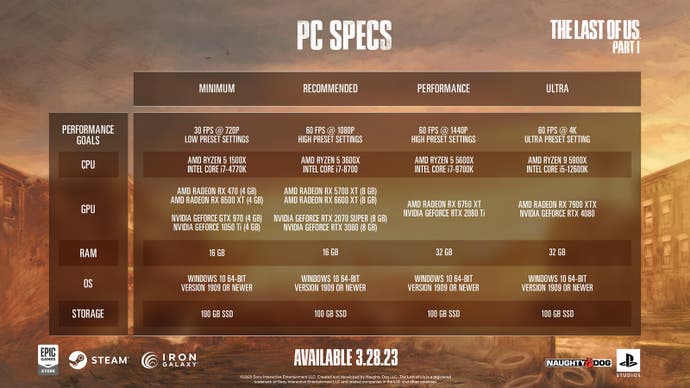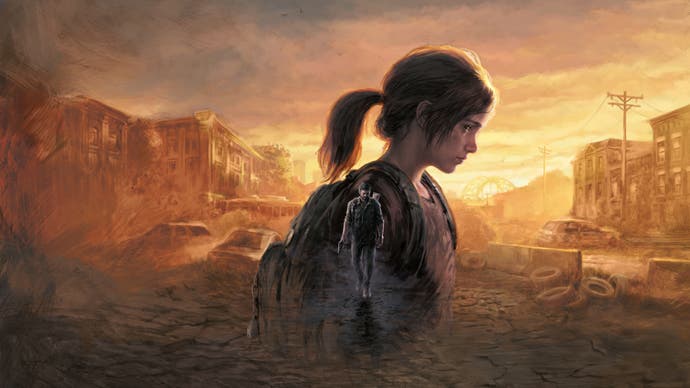DF Direct Weekly: The Last of Us Part 1 PC requirements hint at an impressive port
Plus: Halo Infinite gets ray tracing and the Sony/Microsoft feud escalates.
Late last week Naughty Dog revealed the recommended PC specs for The Last of Us Part 1, with a surprising amount of detail provided in their blog post - down to the exact hardware necessary to obtain 4K 60fps at ultra settings. While the blog post is in some ways self-explanatory and straightforward, reading between the lines there's actually a fair amount we can discern about the port. That's exactly what we did in DF Weekly #102, where PC nerd trio Alex, Rich and Oliver espoused some interesting possibilities ahead of the game's release on PC in almost exactly two weeks' time.
First up, the presence of DLSS and FSR 2.2 is a huge deal for PC players, as it means that users of any modern GPU will be able to play the game at higher frame-rates - particularly important for 'heavy' AAA games like this one - but perhaps equally as important, as it means that there will be a higher-quality alternative to the game's usual TAA, which exhibits some break-up and shimmer on PS5. If these upscaling techniques are used at their maximum quality setting, then we'd expect a cleaner and more stable presentation overall, which would be a nice bonus.
Secondly, based on the presence of an ultra preset and the extremely high requirements for even 1440p 60fps - listed as the formerly $1000 RTX 2080 Ti - we can expect the game to offer some graphical advantages over the PS5 version which already looks great. Part of this will be the expectation to hit both 4K and 60fps on higher-end systems, whereas PS5 users have to choose between 4K 30fps or 1440p 60fps, but even with this in mind we'd expect to see some scaling beyond the PS5 version in terms of relatively-easy-to-tweak settings like draw distances, shadow quality and so on. It remains to be seen how impactful those changes would be, but there's certainly some potential here for a sparkling PC port on high-end hardware - including a native ultrawide presentation in 21:9 or 32:9 aspect ratios, which as Alex points out during the show, often requires a significant time investment to implement in in-game cutscenes.
As well as the top end, the minimum spec requirements are fascinating. The game has been promised to run on Steam Deck by Naughty Dog's Neil Druckmann, but the minimum requirements listed, including a GTX 970 and GTX 1050 Ti are some way beyond the Steam Deck's capabilities. Normally you might expect that the Steam Deck could run the game at a lower resolution or frame-rate to compensate, but the minimum specs already list a 720p resolution at 30fps with low settings - so is Steam Deck going to struggle with the game, despite possessing roughly PS4-equivalent GPU performance at 720p, or has the game been optimised for Steam Deck such that we see significantly better performance than usual in comparison to desktop GPUs like the GTX 970? Or is FSR required to get the game running stably, in which case we'd expect something like a 540p native resolution or lower? Each option is intriguing, but we'll have to wait for the full game to know for sure.

The other news covered in this week's Direct was also intriguing, with Starfield finally getting a release date (although later than expected) and reports from Bloomberg of Suicide Squad being delayed following its rather disappointing recent showing at PlayStation State of Play. In both cases, the delays make sense, especially given Bethesda's predilection to deliver huge, beautiful game worlds initially full of bugs, but Suicide Squad might be too far gone to be 'saved' from its games-as-a-service nature. We also covered the ever-evolving Microsoft and Sony circus, with Microsoft's plausible claim that Call of Duty could come to Switch (and GeForce Now customers), amounting to 150 million new devices, plus the addition of ray tracing to Halo Infinite's multiplayer. Interesting stuff!
Elsewhere in the Directaverse, we covered some big topics in response to Digital Foundry supporter questions. My favourite of the questions this week was from Zephyr, who asked whether in-house game engines are becoming infeasible. It's something that I've been thinking about a lot, as we've seen quite a few high profile cases of own-brand engines struggling to match competitors, notably Unreal, in terms of features and polish. However, we've also clearly seen the downsides of a single game engine being used for so many titles, with a kind of 'Unreal Engine 4' look that now permeates the gaming space and makes it hard for most games to set themselves apart visually. It's also, it has to be said, likely one of the reasons behind the current #StutterStruggle epidemic on PC, with Unreal Engine 4 games being the most common offenders of Alex Battaglia's patience.

- 00:00:00 Introduction
- 00:00:52 News 01: Starfield gets a release date, Suicide Squad delayed
- 00:11:18 News 02: The Last of Us Part 1 PC features detailed!
- 00:22:46 News 03: Sony-Microsoft feud escalates with dueling Call of Duty claims
- 00:36:50 News 04: Halo Infinite PC gets ray tracing!
- 00:44:14 Supporter Q1: Are in-house game engines becoming no longer feasible?
- 00:52:10 Supporter Q2: Would DF be interested in producing PC build videos?
- 00:57:41 Supporter Q3: With Moore’s Law slowing down, will PCs or consoles need to switch to ARM for performance gains?
- 01:03:33 Supporter Q4: Would Alex consider making a new “do you really need ultra settings” video, given the advent of new PC technologies like DLSS?
- 01:05:49 Supporter Q5: Where has Alex’s Crysis Shrine gone? Has it been destroyed by Alex’s rage over #StutterStruggle?
I think there's definitely a danger that the industry as a whole becomes too reliant on Unreal, and we lose a lot of the unique technical and design solutions that in-house engines can provide. At the same time though, using Unreal doesn't necessarily mean that your game will be bland. Hi-Fi Rush is a great example of this that I cited the last time this topic was raised, as a UE4 game that looks nothing like its peers.
And as Alex points out in the Direct, there are still game studios like iD and Infinity Ward that are able to achieve much better performance and features thanks to their in-house engines than would be possible with Unreal. So while bespoke game engines are becoming less common, veteran studios can still make a case for forging their own path, especially when they can afford to take the time to deliver polished results. So many of the technically shaky games developed with in-house engines are being lambasted not because the engines are bad, but because these individual projects are not being given quite enough time or resources to launch in a more polished state. Hopefully, the same pressure that is pushing some studios to switch to Unreal will also cause other studios to stay on their own tech - and just spend a bit more time tackling technical issues to ensure the game gets a warm reception.
There are some other great questions in this week's Direct, including whether we'd ever make PC build videos, the potential for consoles to switch from x86 to ARM-based processors and the current whereabouts of Alex's Crysis shrine.
If you'd like to submit your own questions for the Direct, then do consider supporting us on Patreon. As well as the chance to influence the direction of future DF projects, you'll also be invited to join the lovely community on Discord, be kept up to date with our latest projects and see content - including DF Direct! - before it reaches the wider public. So: join us! We'd love to have you.

















